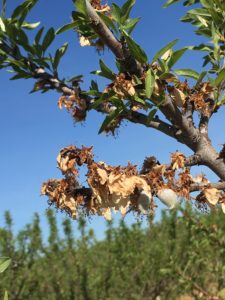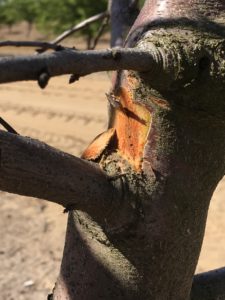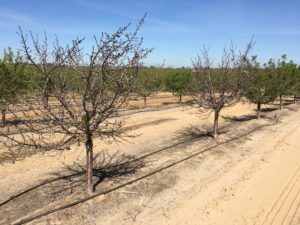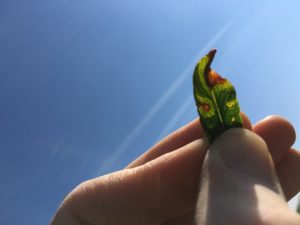
Over the past few weeks, there have been a high frequency of problems reported with bacterial canker and blast. Bacterial blast results in blighted blossoms and causes crop loss. Interestingly, when there is a high frequency of blast, the very similar disease of bacterial canker appears a few weeks later in young trees(we are starting to get reports of canker now). Both of these problems are complicated. They involve the bacterium Pseudomonas syringae, plant stress which is often mediated by nematodes, and the weather.
P. syringae is an interesting bacteria. It lives naturally on plant surfaces as an epiphyte – meaning that it generally does not cause problems. During wet winters which create a favorable environment, bacterial populations increase and spread through the tree and orchard. At some point the population becomes large enough that it begins to invade plant tissues – starting with buds (bud drop), then flowers (blast), and finally bud scars and other openings which leads to bacterial canker.
Tree health has a lot to do with the susceptibility to P. syringae infection. Generally, if the tree is healthy, infections rarely occur. Weak, young trees- usually three years or less- are susceptible to bacterial canker which can cause the loss of tree scaffolds or death. Mature orchards usually don’t exhibit bacterial canker symptoms, but rather have blast and bud drop problems. Orchards with severe problems are typically planted in sandy soils, which often tend to be acidic, hold less water and nutrients as well as being more conducive to plant parasitic nematodes. All of these factors, if managed improperly, can increase tree stress, increasing susceptibility. Some micronutrient deficiencies, notably iron, have been found to increase susceptibility, while balanced, proper major nutrient fertilization has been shown to reduce occurrence. Severe water stress can also increase occurrence, and is thought to be due to the reduced carbohydrate reserves within the tree.

Nematodes (especially Ring nematode) and other replant problems have been linked to an increased occurrence of bacterial canker, blast, and bud drop. Susceptible rootstocks (e.g. peach-almond hybrids) should not be planted within soils in which ring nematode is present or expected. Resistant or tolerant rootstocks should be considered within these soils. Localized test plots have found that Viking rootstock generally has reduced bacterial canker occurrence in comparison to Nemaguard or Hansen 536. The data on other peach-almond hybrids is unclear.
Managing bacterial bud drop, blast, and canker is difficult and there are no “silver bullets.” Pre-plant soil fumigation is recommended to assist in nematode suppression and to help increase young tree vigor. The use of Viking rootstock should also be considered. Proper irrigation and fertilization practices should be implemented to increase growth and vigor. Lo biuret urea sprays made in the fall help reduce canker size. Copper containing sprays could also be made, but the reviewed data is a bit unclear on the consistency of copper efficacy. Generally, a late fall and a mid-dormant spray seem to reduce canker and blast occurrence. Post-plant nematicides have helped in reducing bud drop in some locations, but the efficacy of many post-plant nematicides varies orchard-to-orchard. Later pruning also seems to reduce canker occurrence. Specifically for blast, the use of effective frost control practices can reduce the severity of blast and should be implemented. Generally, as many practices as possible to improve tree vigor should be implemented.
More information can be found at the UC IPM website entry on bacterial canker.




Rod Vilas
March 28, 2017Thanks for the post David. I have been dealing with this to some degree for the past 3 years now. This year is by far the worst. Most of what I see is bud drop, or buds that are still on the tree, but will fall off with a flick of the finger. I also had blighted flowers, but mostly bud drop. These are orchards that are younger (3-8) and very healthy. Hopefully we can find a “silver bullet” for this issue, as I hear from many other growers that are dealing with it in some form or another.
David Doll
March 29, 2017Thanks Rod,
I am glad you found it helpful. Yes, this has been a serious problem this year. Hopefully, we will be able to eventually determine the environmental conditions that are associated with the problem. Still a lot to learn!
David
Something new we have to worry about the Almond Hull Crop – Feedservices Co.
March 28, 2019[…] new we have to worry about the Almond Hull Crop myoung Uncategorized 0 Comment Bacterial Canker and Blast Over the past few weeks, there have been a high frequency of problems reported with bacterial […]
Jake
February 23, 2020Hi David!
We lost a decent amount of 3 leaf trees on Hansen after a 30-40 mph wind went through late last year. Some foliar symptoms of blast were noticed, but in very small amounts. The majority of the trees split down the middle and appeared to have a “rotten” heart (worst damage noticed were Aldridge.)
Will bacterial canter cause cause trees to split and lose a whole tree or a scaffold? Same varieties and aged trees are planted across the street, on soil with higher gravel content, with little to no tree lose. Only difference being different nurseries.
Not noticing a lot of “gumming” and trees seem to be holding onto bloom with normal looking leaf emergence. Nematode samples came back with zero nematodes noticed.
Thanks,
Jake
David Doll
March 26, 2020Jake,
The symptoms you described are not caused by blast. This sounds like an issue with heart rot, which is caused by a group of fungi within the Ganoderma family. This fungus slowly breaks down the cells within the xylem tissue of the tree, reducing the structural integrity. When there is a large storm, the branches break. It can be reduced by preventing damage to the tree, including large pruning cuts and shaker damage.
Best of luck,
David
Majid
March 3, 2021Hi.
I’m from Iran.I have an almond orchard which has been infected by bacterial canker.I have sprayed it before by Copprer oxychloride.please let me know the best way to save the orchard.
Thanks
M.Raeesi
David Doll
March 3, 2021Dear Majid,
Bacterial canker is a complicated problem. Usually it occurs when the tree is significantly stressed. Outside of copper sprays, some farmers try to increase tree health by better fertilization, irrigation, and general management. There does seem to be some reduction of symptoms if calcium containing fertilizers are used. Foliar nitrogen sprays have also been shown to help. If nematodes are causing the stress, replanting with resistant rootstocks or treating the soil can help reduce populations. Lastly, delay pruning until the occurrence of symptoms have passed. This way you can select limbs unaffected by the disease.
David